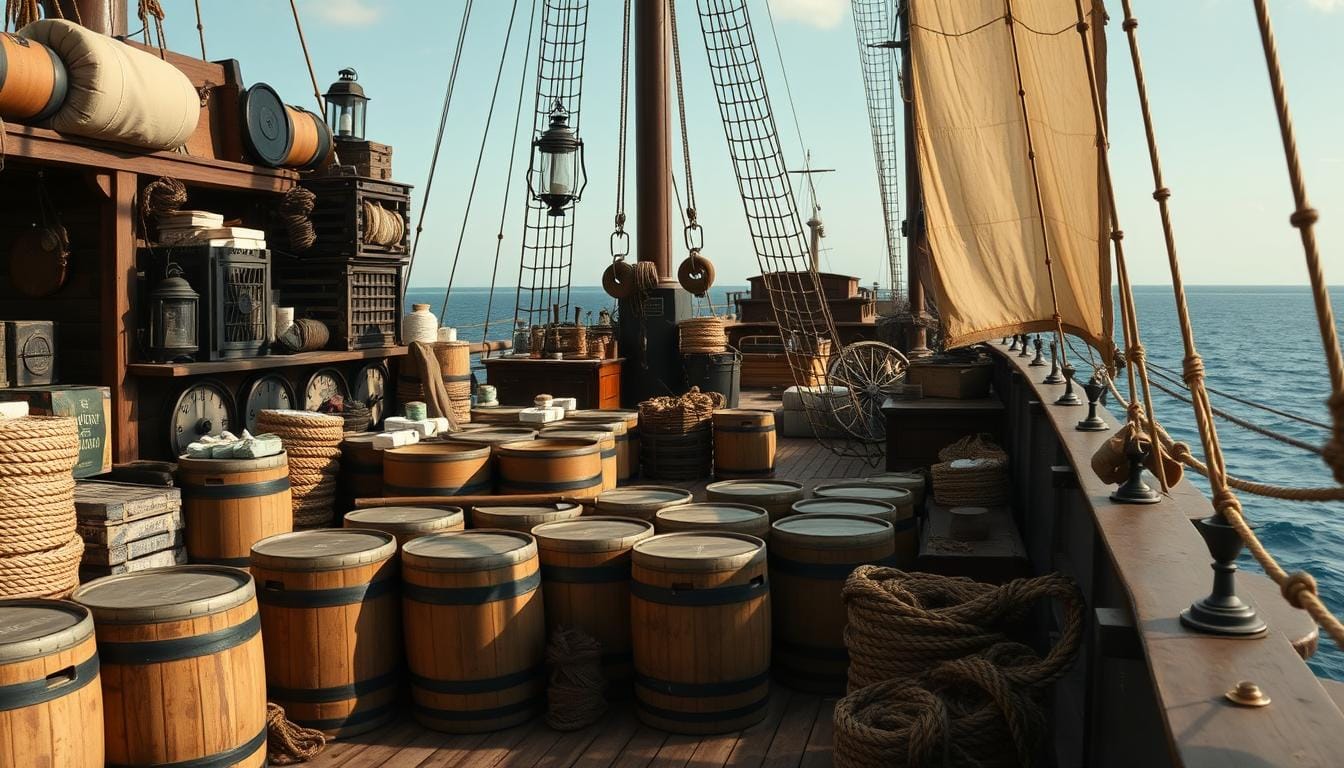Navigating the High Seas: Life on a Regency-Era Naval Ship
During the Regency era, from 1811 to 1820, 40% of British sailors lost their lives at sea. This shows the dangers and challenges of life on a naval ship back then. The British Navy was very active during this time, making it key to understand the era.
The Regency era was full of change and turmoil. The regency navy was at the heart of these changes. We'll look into the daily lives of sailors, the ship's hierarchy, and the challenges they faced. This will help us understand the regency navy and life on its ships.
Life on a Regency-Era Naval Ship: A Historical Overview
In the Regency era, living on a British naval ship was key for sailors. The navy was at its peak, ruling the seas. This time was known as the sailing ship's golden age, with the British Empire growing.
The early 1800s were when the navy became a big deal. Ships sailed everywhere, facing tough sea life. Despite cramped spaces and few comforts, sailors kept the empire strong.
The Golden Age of Sailing Ships
This era brought new sailing tech and bigger ships. The navy led these changes, showing British power and pride.
The British Naval Empire
The British Empire's navy was a big deal in the Regency era. Its ships kept the seas under control. The navy's good living spaces helped sailors stay at sea for long stretches of time.
Maritime Dominance in the Early 1800s
The early 1800s saw many battles, like the Napoleonic Wars. The navy's ships were built to last, helping the crew in tough times.
The Physical Structure of Naval Vessels

The design of regency naval vessels aimed to withstand harsh sea conditions. They needed space for crew, supplies, and weapons. The physical structure was key to their functionality. Naval ship supplies were stored carefully for easy access and to reduce waste.
The decks on these ships were laid out for efficiency. Upper decks held weapons and navigation tools. Lower decks were for storage and crew quarters. This layout helped the ship run smoothly and kept the crew safe.
These vessels were built with strong materials like oak and teak. These materials gave the ships strength and stability. This construction allowed them to last long in the sea's harsh conditions. The ships' design showed the skill and creativity of shipbuilders.
In summary, the physical structure of regency naval vessels was vital. The way supplies were stored and the deck layout helped their success. The use of durable materials and smart design made these ships a powerful force on the seas for many years.
Hierarchy and Command Structure Aboard Ship
Knowing the hierarchy and command structure on a Regency-era naval ship is key. It helps us understand the social dynamics and how the ship worked. The chain of command was vital for keeping order and ensuring the ship ran smoothly. Sailors lived and worked in a strict system, with each person having their role.
Officers were at the center, overseeing the ship's daily tasks. They handled navigation, tactics, discipline, and morale. Common sailors did various jobs, like cleaning decks and climbing rigging. The ship's layout showed this hierarchy, with officers in better quarters and sailors in cramped spaces.
Haunted by the scars of war, Daniel Langdon retreats to a family friend’s estate in Scotland, resigned to despair—until the unexpected presence of Elenore MacAllister, his childhood sweetheart, stirs a flicker of hope. As Elenore works to heal the brooding man who once captured her heart, she must summon all her love and courage to help him find peace and rekindle the joy they once shared.
Officers and Their Roles
Officers made important decisions, like the ship's path and battle strategies. They also kept discipline and followed rules. Their quarters were better than those of common sailors, showing their higher status.
Common Sailors and Their Duties
Common sailors did most of the hard work on the ship. They worked long hours in tough conditions to keep the ship going. Despite the challenges, sailors were proud of their work and the camaraderie they shared.
The Chain of Command
The chain of command was clear and well-organized. Each level had to oversee the one below it. This structure was crucial for order and efficiency. By understanding this, we can appreciate the lives of sailors and the importance of their living conditions.
Living Quarters and Sleeping Arrangements
Life on a Regency-era naval ship was tough, with cramped and simple living spaces. These spaces were made to be useful, not comfortable. Sailors often shared small areas with others, showing the strict nature of life at sea.
The ship's quarters were planned to help the crew work well together. Sailors slept in hammocks or narrow bunks, with little room for their things. Mess areas were small too, where sailors ate and talked close together. Despite the hard conditions, sailors formed strong bonds, helping each other on long sea trips.
Sailors learned to live well in their limited spaces, showing the importance of these areas in their lives. By looking at these quarters, we understand better the challenges and experiences of sailors back then.
Historical accounts show sailors found creative ways to deal with the tight spaces. They made fun areas or made their spaces their own. This shows their cleverness and strength in facing life at sea.
Daily Routines and Watch Systems
Regency-era sailors followed a strict daily routine at sea. This routine was key to keeping order and discipline on board. It helped them stay focused and alert, ensuring the ship ran smoothly.
Morning Duties
A typical day started with morning duties. These included cleaning the ship's decks and equipment.
Watch Rotations
After morning duties, sailors took their watch rotations. Watch rotations were crucial. They made sure the ship was always manned and ready for anything.
Evening Protocols
In the evening, sailors followed protocols to secure the ship. These evening steps were vital for safety and security. A strict daily routine helped sailors maintain discipline and order, essential for the ship's success.
The daily routine at sea was vital for regency-era sailors. It helped keep order, discipline, and a sense of community. Understanding their routines and watch systems shows us the challenges and complexities of life at sea in the age of sailing.
Naval Food and Provisions at Sea
Life on regency naval vessels needed careful planning for food and supplies. The ships had limited space for storage. Sailors ate salted meats, dried fruits, and biscuits because they lasted long.
Managing food on these ships was key to keeping sailors healthy. Supplies were planned and stocked to keep food fresh. This included salted meats, dried fruits, biscuits, and other essentials like water and medical gear.
Despite the challenges, regency naval vessels kept their crews fed. This was thanks to good planning and preservation methods like salting and drying. Food and supplies were crucial for long voyages and successful missions.
Regency naval vessels were able to provide their crews with a relatively stable food supply, despite the challenges of maintaining a healthy diet at sea. This was due in part to the careful planning and management of naval ship supplies.
Health and Medicine Aboard Ship
Lady Amaryllis Langdon, a spirited tomboy with no desire to wed, flees an arranged marriage to carve out her own destiny. But when Ship's Surgeon Gavin MacAllister, the man she secretly loves, discovers her disguised as a powder boy aboard his naval ship, he must battle his feelings and her stubbornness to protect her—knowing their love is destined to remain out of reach.
Life at sea in the Regency era was risky due to tight spaces and limited medical help. The navy culture focused on keeping sailors healthy for success. Activities like swabbing and climbing were also risky.
Scurvy and dysentery were common among sailors because of bad sanitation and limited fresh food and water. The ship's surgeon was key in treating these illnesses and doing surgeries. They had to use their skills and experience to care for the sailors.
Despite the challenges, the navy culture valued sailor health and happiness. They encouraged exercise and fun to keep spirits high and bodies fit. These efforts helped reduce the dangers of life at sea and kept the navy strong.
Entertainment and Leisure Activities
When Royal Navy Lieutenant James Langdon escapes captivity to save his family, he takes Angelique deRoos hostage to secure his freedom, unknowingly entangling himself in her own desperate plans to flee the city. As they evade danger together, their mutual distrust gives way to an undeniable attraction that threatens to upend both their lives.

Life as a regency-era sailor wasn't just about work. Despite tough conditions and strict rules, sailors enjoyed their free time. Music and stories were big hits, boosting spirits and breaking the sea's monotony. They'd share tales of adventure and sing sea shanties that carried far.
Games were also a big part of their fun. Sailors played cards, dice, and board games to kill time. These activities brought them together, creating a sense of community and friendship. For them, these breaks were crucial for their mental health and happiness.
Regency-era sailors found ways to enjoy their time at sea. Music, stories, and games made their journey more enjoyable. By looking into these activities, we can better understand their lives and the joy they found amidst challenges.
Leisure activities were key for regency-era sailors, offering a much-needed break. Exploring these activities helps us see their lives in a new light. It shows how they thrived despite the hardships.
Naval Discipline and Punishment
Life on a regency navy ship was strict, with clear rules and punishments. The navy had a strict hierarchy, and living quarters showed this. Common problems like disobedience, drunkenness, and theft were punished harshly.
Punishments varied based on the crime. Small mistakes might mean extra work or losing privileges. But serious crimes could lead to flogging, jail, or even a court-martial. Courts martial were serious, aiming to keep order and justice in the navy.
Living conditions on the ship were key to keeping order. The navy worked hard to keep sailors happy and healthy. By understanding the discipline system, we see the tough life of sailors on these ships.
Common Offenses
On a regency navy ship, disobeying orders, getting drunk, and stealing were big no-nos. These actions were punished severely.
Types of Punishment
Punishments varied with the crime's severity. Small mistakes got extra work or lost privileges. But serious crimes faced flogging, jail, or court-martial.
Courts Martial
Courts martial were serious and fair, aiming to keep justice and order in the navy. The navy believed in a fair system to keep sailors happy and healthy.
Navigation and Sailing Techniques
Regency naval vessels used old knowledge and new tech to sail the seas. Life on these ships was all about finding your way, thanks to charts, compasses, and the stars.
Sailors looked up at the stars to figure out where they were. This was key for long trips. They also used charts and compasses for closer waters.
But it wasn't just about finding your way. Sailing was a big part of life on these ships. They were built to go fast and far, using tricks like tacking to catch the wind.
Navigating the high seas was a complex and challenging task, requiring a deep understanding of the stars, winds, and currents. Despite these challenges, regency naval vessels were able to establish trade routes and explore new lands, shaping the course of history.
Combat Training and Battle Readiness

Life on a Regency-era naval ship was more than just sailing and exploring. It was also about being ready for battle. The navy culture focused on combat training and being ready for battle. Sailors practiced gun drills, learned battle stations, and prepared for emergencies.
Combat training was key for sailors. They learned how to handle guns, fight with swords, and follow emergency procedures. This training kept them safe and helped the mission succeed.
Gun Drills
Gun drills were vital for combat training. Sailors had to load, aim, and fire guns fast and accurately. They needed lots of practice to work together well and fire guns safely.
Battle Stations
Battle stations were where sailors went during combat. Each had a specific role. They had to move fast and work together to respond quickly in battle.
Emergency Procedures
Emergency procedures were also crucial. Sailors had to act fast in emergencies like fires or breaches. They needed lots of training to handle these situations safely and effectively.
Religious Life and Spiritual Practices
For regency-era sailors, life on a naval ship was more than duty and discipline. It was also about faith and spirituality. The tight spaces and harsh conditions made religious life and spiritual practices crucial for comfort and solace. Many found strength in their faith, helping them deal with the dangers and uncertainties of life at sea.
Prayer services and religious rituals were common among regency-era sailors. They provided a sense of community and shared purpose. These practices helped foster a sense of belonging and camaraderie among sailors, which was key for their mental and emotional well-being. Even in basic naval ship accommodations, there was often a small chapel or prayer room for worship and reflection.
Personal devotions and quiet reflection were also key for regency-era sailors. Many kept personal journals or prayer books to record their thoughts, feelings, and spiritual struggles. These private devotions helped sailors process their experiences and emotions, finding meaning and purpose in their lives. By looking into the religious life and spiritual practices of regency-era sailors, we can better understand the complexities and challenges of life on a naval ship during that time.
Religious life and spiritual practices played a significant role in the lives of regency-era sailors, providing comfort, solace, and a sense of community in the midst of uncertainty and danger.
Pay, Prize Money and Financial Matters
The money matters on a regency navy ship were key to sailors' happiness and the ship's success. Also, managing supplies was crucial to keep the crew fed and happy during long trips.
Records show that sailors' pay changed with their rank and experience. They also got prize money for capturing enemy ships. The navy had a detailed plan for its money, including how to buy and share supplies.
Managing supplies was a big deal for the regency navy. They had to keep their ships full of food, water, and more. This helped keep sailors healthy and happy. The navy's money management was vital for its success.
The financial aspects of life on a regency navy ship were a vital part of its operations, and the management of naval ship supplies was essential to the well-being of its sailors.
In short, money matters were crucial for the regency navy's success. Pay, prize money, and supply management were all important. These helped the navy operate well and keep its sailors happy.
Communication Systems at Sea
Life on a regency-era naval ship depended on good communication. They used signal flags, maritime methods, and message systems. These tools were key for safety and coordination.
Signal flags were at the center of these systems. They helped ships send complex messages to each other.
Signal Flags
Signal flags were crucial for regency naval ships. They allowed ships to talk to each other and coastal stations. This way, they could send messages fast, even in battle.
Message Delivery Systems
Message delivery systems were also vital. They helped ships send and receive messages over long distances. This was important for staying connected with commanders and getting updates on enemy movements.
Communication systems were essential for life on a regency-era naval ship. They helped ships work together, follow orders, and share important information. Understanding these systems helps us appreciate the challenges faced by sailors back then.
The Legacy of Regency Naval Life
The world of Regency-era naval ships is truly captivating. The regency-era sailors left a lasting impact on history. Their discipline, bravery, and regency navy culture helped the British Empire rule the seas.
Their skills in navigation and following naval traditions still shape our maritime ways today. Their ability to overcome challenges has inspired many. It shows the crucial role of naval forces in that time.
The stories of Regency-era sailors are still fascinating today. They capture the hearts of many. By exploring this era, we learn about the triumphs and struggles of those who sailed the seas.
Let us know what you think in the comments!
Created with ©systeme.io






